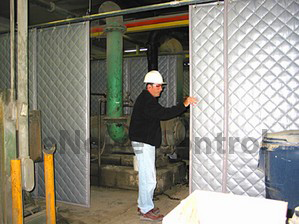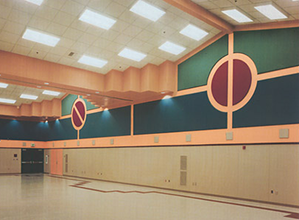Guide to Buying The Best Industrial Sound Curtains
Industrial sound curtains are an extremely effective way to reduce noise for a variety of applications. Their extensive uses and diverse quality options can make it difficult to purchase the right curtains for your particular use. Certain aspects of industrial sound curtains, such as the sound transmission loss (STC), noise reduction (NRC), weather-proofing capabilities, mounting system, and price, need to be considered when making a purchase.
To make sure you are well equipped with the knowledge to purchase the best industrial sound curtains for your particular use, we have put together a guide: Industrial Sound Curtains 101.
What are Industrial Sound Curtains?
Sound curtains are used in many industrial, commercial and OEM (Original Equipment Manufacturer) applications. These curtains can be used in households but are typically used for more heavy duty noise reduction. Industrial sound curtains are popular for construction companies because they can be easily removed after completing one project and reused for the next project.
Some typical uses include compressor noise control, hydraulic pump enclosures, PD blower and HVAC projects. One of the best aspects of industrial sound curtains is their heavy duty vinyl material that allows them to be utilized inside and out.

How Industrial Sound Curtains Work
Sound curtains work by providing a flexible barrier between the source of noises and other spaces. They work on the principles of absorption and redirection. As sound waves move through the air, the shape and material of the industrial sound curtains affect how the waves behave, ultimately deafening the sound.
Industrial sound curtains have a fiberglass quilting that is bonded to the vinyl barrier that adds a second layer of protection from noise. This is similar to insulation in a wall and creates a quieter environment both inside and outside the enclosure.

What to Look For
There are a few aspects of industrial sound curtains to evaluate while deciding what type of curtains will be best for you. These include STC (Sound Transmission Class), Noise Reduction Coefficient (NRC), weather-proofing, ceiling vs floor mounted, and price.
NRC
NRC stands for Noise Reduction Coefficient and this rating measures the absorption of sound. Typically, the higher the rating, the better the product is at absorbing sound.
There are two main factors that attribute to the overall NRC rating, the thickness, and the density. Basically, the thicker the product, the higher the NRC rating and the better the industrial sound curtain is at absorbing noise.
The NRC rating ranges from 0.0-1.0. For example, if an industrial sound curtain has an NRC rating of .45 this means 45% of the sound in the space is absorbed and the other 55% is reflected back into space.
STC
STC stands for Sound Transmission Class and this rating measures how much the product is able to reduce noise. However, instead of measuring the amount of sound that is absorbed, it measures the transmission loss (or how much sound will still come through the other side of the curtain).
STC ratings are found based on sound frequency measurements in Hertz (or Hz). To give a better understanding, most humans are born with the ability to hear frequencies as low as 20 Hz and as high as 20,000 Hz. However, the soundproofing industry has standardized the STC scale and measure measures performance on a range of 125 Hz to 4,000 Hz.
In most cases the higher the STC rating, the better. However, it is important to not solely rely on the STC rating. This rating can be a little misleading because of the scale range. Since the scale starts at 125 Hz instead of 0 Hz, it can be difficult to gauge how well the curtain will reduce sound for lower frequency noises. For example, heavy equipment and bass drums are both below 125 Hz, therefore not applicable to the STC scale.
Weather Resistance
Depending on your particular use, you may want to consider the weather resistance of the industrial sound curtain. Even if you plan to purchase the curtains for an initial indoor use, decide whether you may need outdoor noise control at some point.
There are quite a few industrial sound curtains that have the capability to be used outside; that withstand extremely low temperatures and intense heat. Here at eNoise Control, our industrial sound curtains have the capability to be used both indoor and out. The temperature range for our curtains is -20 to 180 degrees Fahrenheit. However, industrial sound curtains with these features typically cost more (more on cost in the next section).
Ceiling vs. Floor Mounted
Depending on your use, you may want the ability to relocate the industrial sound curtain enclosure without breaking it down. Additionally, you may want the ability to enter and exit the enclosure at various locations.
A ceiling mounted track system will allow the curtains to slide past one another and then reseal with the velcro. This is useful when there is no predetermined enter and exit way, or if the pathway needs to be changed.
A floor mounted support system creates a free-standing curtain enclosure. This system allows for easy set-up, reconfiguration, and relocation.
Price
Ultimately, all of these features will contribute to the price. If you are looking for industrial sound curtains you can reuse without wear and tear, you should see the purchase as an investment and be willing to spend a little more. If your project requires industrial sound curtains for a one time use, then it may not be necessary to invest in a more expensive set.
Typically, the better the industrial sound curtain is at reducing noise the more expensive. The pricing also tends to escalate as the thickness increases and as the temperature resistance range widens.
Additional Considerations
In addition to the features listed previously, some industrial sound curtains come with extra options. Some of these additional features could include windows, color specifications, ventilation options and velcro sealing. Typically, these features don’t affect the cost of the curtains but are important details to consider.
Where to Buy Industrial Sound Curtains
Here at eNoise Control, we provide a selection of high-quality industrial sound curtains to suit a variety of soundproofing needs. eNoise Control’s removable velcro-sealed sound curtains help address sound directly at the source.

If you are looking for more information or are ready to purchase the best industrial sound curtains, give us a call at 888-417-1903 or send us an email to info@enoisecontrol.com.




